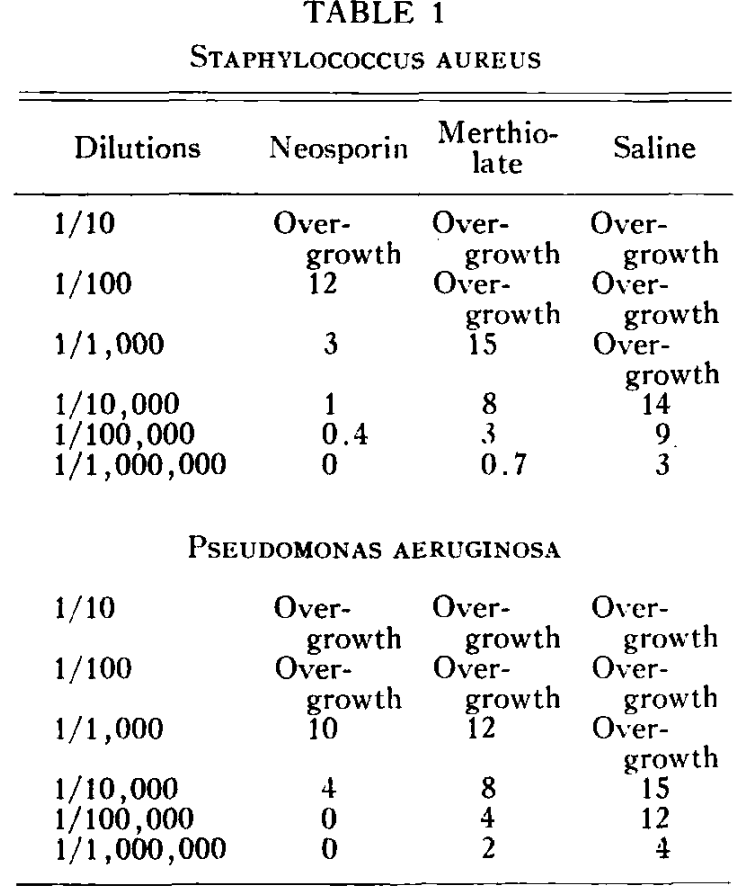DANIEL DOCTOR, M.D., AND IRENE HUGHES, B.A.
New York
Standard procedures for processing donor eyes at the Eye-Bank Laboratory are as follows1:
1. The eye is taken from the bottle in which it arrived and placed in an antibacterial bath.
2. After 10 minutes in the bath, the eye is placed in a fresh sterile bottle containing a cotton dental roll saturated with sterile normal saline to maintain a moist atmosphere. In this bottle the eye is examined to see if it is suitable for corneal graft and, if so, is sent to the surgeon who will use the eye.
3. A culture is taken from the gauze or moisture in the bottom of the original bottle in which the eye arrived, plated on blood agar, and incubated at 37.5°C.
The result of this culture is almost never complete before the eye is used, but the procedure is considered valid, since, if the culture is positive, the organism is identified, sensitivity tests are done and the surgeon is notified immediately. He is also told that the culture was taken before the eye was bathed, and it is our experience that in most cases the contaminating organism is destroyed in the bath.
Until recently the solution in which the eyes were bathed was stainless aqueous merthiolate in 1:5,000 solution with normal saline.
The efficacy of this solution was questioned when we had a case in which a recipient eye became infected after corneal grafting. The culture of the donor eye showed that the eye had been contaminated with Pseudomonas aeruginosa, and the same organism was cultured from the recipient eye.
Although such cases are quite rare, we decided to try a bath of antibiotic solution in place of the merthiolate.
A combination of penicillin and streptomycin in liquid paraffin is routinely used for donor eye storage at the East Grinsted EyeBank in England2, but, because of our experience, we wanted an antibiotic which was effective against Pseudomonas. Hallett, Wolkowicz, and Leopold3, in 1956, found that Neosporin was effective against a wide range of bacteria, including Ps. aeruginosa, and Thygeson 4 of San Francisco was using it for preoperative washing of donor eyes.
We therefore decided to compare Neosporin with merthiolate as a bath for donor eyes.
METHODS AND MATERIALS
Staphylococcus aureus is the organism which was most frequently cultured from donor eyes; Ps. aeruginosa is among the most virulent and difficult to control, so these two organisms were chosen for these experiments.
The staphylococcus cultures used were obtained from the Pathology Laboratory of Manhattan Eye, Ear, and Throat Hospital. All were hemolytic and all were cultured from eyes.
The strain of Ps. aeruginosa was P. 28. Efforts to test other strains failed because, although several strains were sent to us from other laboratories, all but P. 28 died in transit.
Pure cultures of the above organisms were diluted in strengths from 1/10 to 1/1,000,000. Enucleated cats' eyes were immersed in the bacterial baths for one minute and each was then transferred to a bath of merthiolate (1:5,000), Neosporin, or normal saline.
The sequence was as follows:
1. One minute in the bacterial solution.
2. Immersion in antibacterial bath for 10 minutes.
3. Saline wash for two minutes.
4. Eye discarded.
5. Culture taken from the saline wash and plated on blood agar.
After 48 hours' incubation the colonies were counted. A total of 70 eyes were processed in this way, testing the antibacterial agents against each of the two organisms five times.
The results were quite uniform for all of the runs, and the average of colonies counted were as in Table 1.

COMMENT
Human donor eyes are ordinarily enucleated under sterile conditions, irrigated copiously with sterile normal saline or bathed in antibiotic solution and then placed in sterile bottles. Bearing these precautions in mind, it is impossible that a human donor eye would be grossly contaminated.
The high degree of efficacy of Neosporin in the weaker dilutions of bacteria emphasizes the importance of immediate irrigation of the enucleated eye with sterile normal saline, since the mechanical effect of washing the eye is very valuable.
The results of these tests indicate that Neosporin is an effective antibacterial agent against the two organisms tested and was more efficacious than merthiolate, the previously used solution.
In practice, it must be remembered that the recipient eye is also a possible source of contamination. In the experience of The Eye-Bank, positive cultures of the bottles in which donor eyes arrive are becoming fewer and fewer as hospitals become more familiar with The Eye-Bank and the techniques for procuring suitable donor eyes.
CONCLUSIONS
1. Neosporin was tested as an appropriate solution for bathing Eye-Bank eyes. It was found to be highly effective against the weaker dilutions of Staphylococcus aureus and Pseudomonas aeruginosa, the two organisms used in this series of tests. It was found to be superior to merthiolate, the solution previously used.
2. Irrigation of the enucleated eye with sterile normal saline is believed to have an important mechanical effect, washing possible contaminants from the eye.
210 East 64th Street (21).
REFERENCES
1. Paton, R. T.: The Eye-Bank program. Am. J. Ophth., 41:419-424, 1956.
2. Rycroft, B. W.: Corneal Grafts. St. Louis, Mosby, 1955, p. 206.
3. Hallett, J. W., Wolkowicz, M. I., and Leopold, 1. H.: Ophthalmic use of Neosporin. Am. J. Ophth., 41:850, 1956.
4. Thygeson, P.: Personal communication with R. Townley Paton.